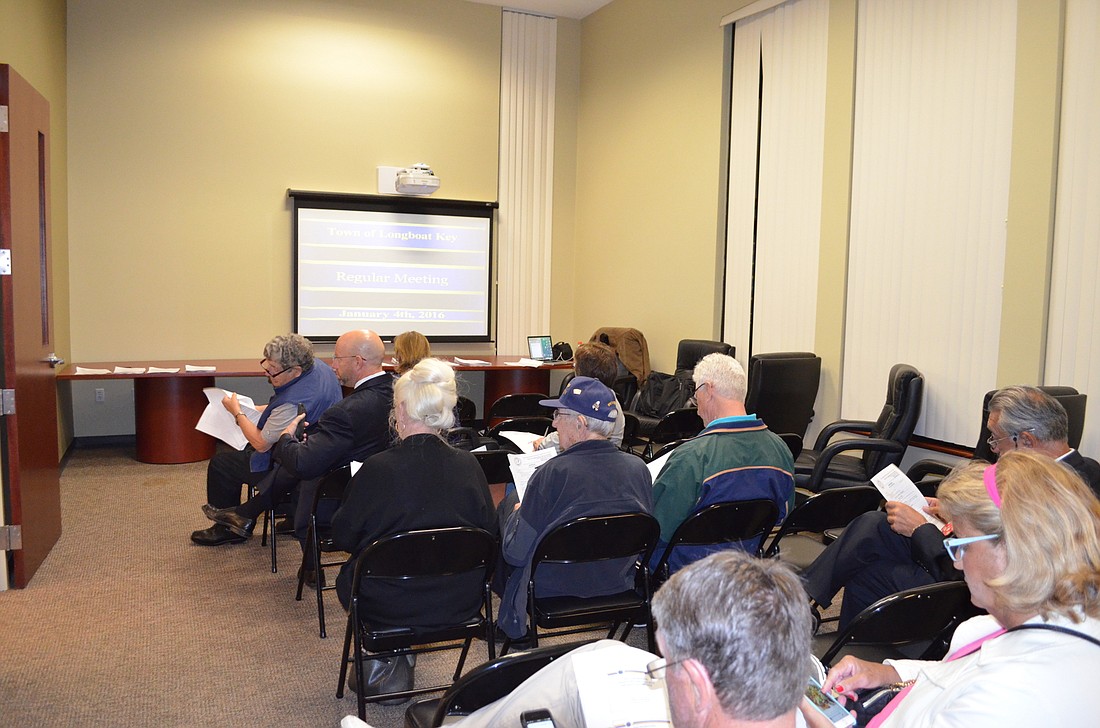- December 12, 2025
-
-
Loading

Loading

It was 1:13 a.m. Jan. 5, when the Longboat Key Town Commission’s 7 p.m. Jan. 4 meeting adjourned. Yes, the meeting lasted six hours and 13 minutes — a possible record, according to Town Clerk Trish Granger.
The crowd filled commission chambers — where a maximum 80 seats are allowed — and the lobby and antechambers, where another 70 seats were set up with TV screens nearby.
And just in case the crowd exceeded 150, the town had a plan to move the meeting to Temple Beth Israel down the road.
Dozens of people spoke to either support or denounce an ordinance that contains referendum language for a neighborhood and side street project to bury above-ground power lines. If voters approve it, the plan will eliminate aerial wires islandwide.
Despite pleas for a more equitable funding formula from residents with above-ground power lines, the commission voted 5-2 to continue with a referendum that will ask voters March 15 if the town can issue bonds not to exceed $23.85 million for the project.
The commission approved the referendum language by a 5-2 vote. Commissioners Phill Younger and Pat Zunz voted against moving forward.
If approved, property owners with existing underground utilities would pay for 18.5% of the project’s cost; owners with above ground utilities would pay for 81.5%.
North end residents with above ground power lines rose to the podium, pleading with the commission not to move forward with the referendum until a more equitable funding formula is achieved.
For many north end communities and side streets, their total upfront cost for a proposed neighborhood and side-street project to bury power lines is $8,500.60 Financing costs over 30 years at the same interest rate, those residents would pay $527.36 annually, for a total cost of $15,820.80. That upfront cost rises to more than $11,000 if they need to upgrade their power grid connection.
“We don’t want it and we didn’t ask for it,” said Longbeach Village resident Allan Luke. “Give us the ability to opt out of this. (Paying more than ) $11,000 for people living on a fixed income is way, way too much.”
Sleepy Lagoon resident Jules Rauch said many residents on a fixed income just can’t afford it.
“Sleepy Lagoon has been served with aerial power lines for more than 50 years,” Rauch said. “Whenever we get a heavy rain, our streets flood. That’s our problem. Not the electric. Most of us are retired and I don’t think it’s fair nor equitable.”
Even new proposals by former mayor and Revitalization Task Force Chairman George Spoll and Younger couldn’t gain traction.
Spoll and task force board member Lenny Landau presented a universal funding solution that calls for every parcel owner to pay $143 annually for 30 years for the neighborhood project, plus the costs of possible upgraded connections needed. Spoll said the proposal translates to a $75 to $111 increase over the present proposal for 72% of the Key’s parcels.
“Abandon this (referendum) for something more fair and equitable,” Spoll said.
But the majority of the commission doesn’t believe that property owners that already have buried power lines will be willing to subsidize the neighborhood project any more than the proposed 18.5%.
“If you think you can push these (property owners with buried power lines) people to pay any more than what we’ve proposed, I think you’re wrong and it’s too much,” said Commissioner Irwin Pastor.
Younger urged the commission to delay the referendum until August to allow staff and consultants to rework the numbers and consider implementing a district program that’s similar to the town’s beach program funding formula, which has property owners on the west side of Gulf of Mexico Drive paying 80% of beach project costs and property owners on the other side paying the remaining 20%.
But Mayor Jack Duncan and others said moving forward with the current proposal in March is critical, both for a better voter turnout and for allowing both projects to be merged to save on construction costs.
“This commission has worked its fannies off in trying to come up with an equitable product here to make this beneficial at a fair cost,” Duncan said. “If it doesn’t pass, then we will have districts that allow individual communities to decide what they want to do.”
Duncan and others though, don’t want to see the neighborhood referendum fail because 84 power poles will be erected just off Gulf of Mexico Drive to funnel power to communities with above ground wires unless they agree to pay to bury their lines.
“If we end up with 84 poles off GMD, the aesthetics and everything we set out to do is challenged in my mind,” Duncan said.
Country Club Shores resident Bob Gault, meanwhile, said he plans to meet with town staff soon to see what’s involved with setting up a district for his community to bury power lines if the referendum fails in March.
“Our top priority is to help get out a CCS ‘yes’ vote in March,” Gault wrote in an email to Country Club Shores residents. “I will meet with the town manager soon to understand what we need to do to prepare should the referendum fail to get approval for a CCS referendum in August to get our neighborhoods cost effectively done in conjunction with the GMD project.”
Ballot language for the referendum is due to county supervisors of election by Jan. 8.